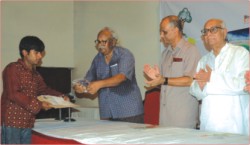| From the Insight Desk
Corruption Metaphors
Abak Hussain

Insight's cartoon contest was not the first one of its kind. The idea, of course, was not very novel. Cartoons are one of the first things that pop into mind when you want witty views on a certain subject but you still want there to be a degree of fun. With cartoons you can stay clear of the real nitty-gritty and reduce complex ideas into a visual metaphor, have a good chuckle, then walk away. Reality, as we all know, is not a cartoon. Even before the whole question of “fighting” corruption arises, corruption is notoriously difficult to even define. There will be those who try to convince you otherwise. Different regimes say it is X, Y, Z and so on, and must be punished in such and such a manner etc. But how much of the system is rotten? And how does one go about standing on “uncorrupted” ground, to begin to “fight” corruption? And when we “fight”, who are we working for?
 |
First Prize : Md. Arifur Rahman |
Ten cartoonists were awarded at the ceremony on 9th August. Winners were picked out of hundreds of entries, many of them quite good, by the panel of judges. There were trade-offs between the criteria. Some had an interesting concept, while others had good draftsmanship. Ideally the best cartoons would have both, but there is always a trade-off. There were some cartoons with such bewilderingly high concepts that the judges were left scratching their heads trying to figure them out. In the end, however, you can't earn the judges' favor by confusing them, even though your work might be “too smart”. Ultimately, we all know that evaluating artistic works is a highly subjective judgment call, so there isn't much use justifying this or that except to say that for millennia, people have been bold enough and have mustered the courage to make subjective judgments with conviction, and given prizes and such on the basis of it. There is no use stopping now.
 |
Second Prize : Sumon Wahed |
Metaphors reduce corruption into a single entity. In the eye of the cartoonist, corruption can be “visualized”. It is no longer an action, or a circumstance, or a necessity, but a “being”. “Corruption” becomes personified as a kind of monstrous singularity against which we may “declare war”. Thus it takes on various forms, usually metaphors for evil borrowed from art and literature. Corruption is: a jar full of worms, it's a rotten looking black ball and we can almost smell it, it's the familiar image of the snake curling back upon itself and swallowing itself, it's a fat bald obviously-evil-looking politician, it's an all-consuming giant, and it's a repulsive looking toad-like creature who has immorally acquired so much money he is making himself sick. In these works, there is room for artistic nuance, but there is not room for reality.
The judges, besides myself, were all well-versed on the subject of corruption cartoons. Most of them were highly accomplished cartoonists themselves with their own sense of visual esthetic firmly in place. They instinctively knew what they liked and disliked, what “works” as a cartoon and what doesn't.
 |
Third Prize : Sadatuddin Ahmed |
Crusades are good for change, but one should subject ones war to a rigorous examination, getting underneath each concept and pulling them out by the roots. The standard definition of corruption is the use of public office for private gain. But what is private gain? What are the other types of gain? Government officials are vested with a certain amount of power. When their position allows them to do something, they do it. Catching them in the act is extremely tricky. The very system that is full of loopholes is what puts officials in positions of power, and later tries to punish culprits. It helps to assume that there are "untouchables" somewhere in the system, incorruptible individuals who periodically spring into action.
In 1987, Brian De Palma made the Hollywood film The Untouchables, based on the 'true' account of a group of cops determined to bring down Al Capone's organization which ruled Chicago at the time. Unlike most American gangster pictures, this is not a cynical film. Eliott Ness and his gang win their crusade and succeed in enforcing Prohibition. Everyone else had been unsuccessful before them because they were corrupt; bought off by Capone's men. Presumably the corruption could go on forever because everybody could be bought off, they were 'touchable', nobody was above feeling tempted by a few good offers. Ness's men were the Untouchables, incorruptible not only to the offer of cash bribes, but also to intimidation and death threats.
 |
| The Winners |
Eliott Ness's idealism is the moral center of the story, but there is the feeling that he isn't always sure of his motivations. After risking his life to the cause of enforcing Prohibition (and winning) he is asked by a journalist that there is talk to repealing Prohibition, and what would Ness do once that happens. “Have a drink”, he says. So this is a case where fighting corruption is not about some absolute morality but about enforcing the law. Are our legal responsibilities different from moral ones? Often the rhetoric of morals is carefully kept separate from law, and often the two are indistinguishable. After all, to accuse to the government-the very government that puts down its foot with the law- of doing 'wrong' is nothing if not a moral stance.
No matter what the problems, there will always be crusades, war. There will always be somewhere to go, and the possibility of redemption. Even after all this, it is possible to put the pessimism on hold and hope for better days.
 |
Hasan Mashhud Chowdhury speaking on Anti-corruption |
Copyright
(R) thedailystar.net 2007 |
|
